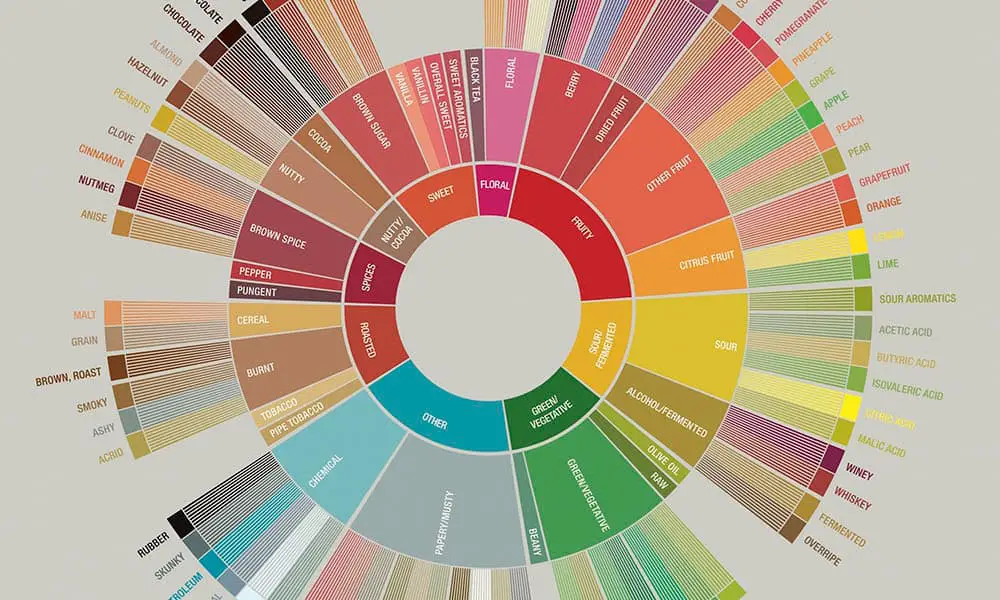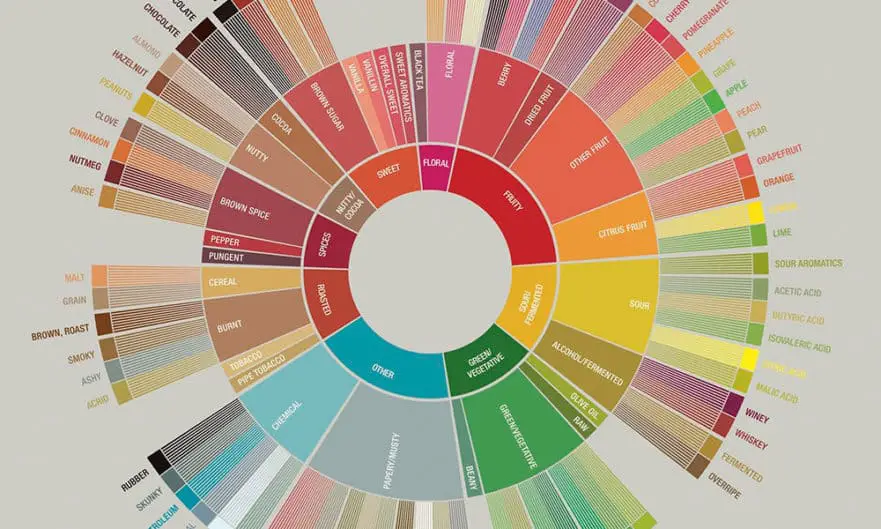
Here is a list of coffee flavor characteristics by some of the most popular coffee growing countries that will help you with buying coffee and tasting coffee. It can also give you an idea of what to look for if you decide to roast your green coffee at home.
Coffee has many, many flavors and if you don’t know where the coffee comes from, there is no way of knowing exactly which flavors you are going to find in your cup of joe.
The reason for this is because there are alot of variables that can and do influence the flavors of a bean, which include:
- Soil
- Fermentation
- Roasting
- Brewing methods
There are, however, flavors that keep coming back when you taste coffee from certain countries and this brief list should give you a start of what to look for.
Keep in mind that this is not a list that will tell you exactly what you will find in your cup as that is highly dependent on many things, most importantly of which is the coffee roaster, who, can heavily influence what you taste in the cup.
So, with that in mind lets get started!
Kenya
Big, bold and juicy, Kenyan coffees are a product of their variety (SL-28 and SL-34 are the most prized), processing (there is a post fermentation soak that can last a day or longer) and the fact that much of the coffee is grown without shade.
These elements (and probably many many others) come together to give Kenyan coffees a mouth puckering savory sweet characteristic that sometimes manifests as a tomato like acidity, other times a black currant tartness.
There is something almost universally tropical tasting about good quality Kenyan coffees, and many coffee professionals will admit that they are a favorite.
Uganda
The dry fragrance has a clean, lemon cookie scent, softly fruited and nicely sweet, a chocolate biscuit quality in the dry grounds, and a plum like dark fruit in the wet aroma. There’s definitely a wild note in there, something like woodsy and rustic lurking in the background.
Indonesia
Again we see the result of variety, processing and climate with the coffees from Indonesia, which tend to have a deep, dark, almost meaty earthiness to them. Sumatran coffees in particular take to dark roasting well and so there are often smokey and toasted flavors present in the cup.
Others will have a stouty or mushroom like complexity that is both savory and herbaceous and a long lasting finish that feels like very dark or unsweetened cocoa.
Sumatra Mandheling Organic Fair Trade
A dry processed coffee with the low acidity, full body and rich earthiness that made Sumatra coffee famous. Complex flavors make a great stand alone drip or espresso or blending base.
Sulawesi Tana Toraja Microlot
Melted butter smoothness and heavy bodied with tangy acidity and flavors of chocolate nut and herbs. Extraordinarily complex coffee that responds dramatically to the roast.
Rwanda Kigeyo Bourbon Mayaguez
Meticulously picked for ripeness, Rwandan coffee is intense and sweet, with savory caramel flavors and juicy acidity.
Central America
This area provides coffee that is well balanced and is the best choice for the first time coffee drinker.
With the exception of Belize, Central America as a whole is a large contributor to the global coffee supply, and along with its southerly neighbor Colombia, coffee from this region of the world is what has most informed the North American coffee drinking preferences and habits. (After all, Guatemala and Honduras are much closer to the states than any African coffee growing region is and its easier for us to buy from them than to ship beans clear across the wide expanse of the Atlantic Ocean.
Due in part to similar climate and altitude, processing techniques and the selection of coffee varieties grown here, we can expect cup qualities from this region to contain varying amounts of acidity (more apple-ish and malic in Guatemala: cherry-like in Mexico) and a smooth sugar browning sweetness that is sometimes soft chocolate like or buttery alike flaky pastry crust.
“Balance” is a word that often comes up when describing these coffees, and their fruit like characteristics often play nice as a mild backdrop to the cocoa and spice flavors
South America
Colombian coffees are most often what people think of with South America and rightfully so. The country is routinely listed among the top 3 coffee producing countries in the world.
The classic Colombian profile, as with other better quality beans form Peru, etc., brings together a mellow acidity and a strong caramel sweetness, perhaps with a nutty undertone. Sweet and medium bodied, they have the most recognizable coffee flavor to most North Americans.
Brazil
Why should Brazil stand alone when the rest of the America’s get clumped together in bigger groups? For one thing, the country is a huge producer and the quality of the output varies widely. Some Brazilian beans, especially those that are pulp natural or Brazil natural have a pronounced peanutty quality and heavy body that makes them common components in espresso blends.
Chocolate and some spice is typical, and the coffee tends to linger in the mouth, with a less clean aftertaste than other South American regions stuff
Ethiopia
Ok, and why should Ethiopia stand on its own? Well, for one thing, the country has vastly more in the way of biodiversity: Thousands of varities of coffee are grown here, mostly wild and uncategorized and the spectrum of flavor then has the potential to be much bigger
Also, processing differs even within Ethiopia in a way that is mostly doesn’t elsewhere with the possible exception of Brazil. In Ethiopia, coffees can be processed either a natural when the cherry is dried around the coffee bean before being removed or “washed” werein the fruit gets stripped within 12 hours of picking.
These 2 processes create strikingly different flavor profiles. Naturals tend to be fruity, heavy and wine like where washed coffees tend to have floral, tea like delicacy to them.
Naturally processed Ethiopian coffees often have a syrupy body that accompanies a densely sweet berry flavor, typically blueberry or strawberry. Washed coffees often express jasmine or lemongrass characteristics and are lighter, drier on the palate.
Hawaii
Dry fragrance from this coffee that has a muted fruity quality, with a dusting of cocoa powder. It has a sweet grain, maple syrup, dark honey and chocolate note. You can sense a bit of sweet melted butter and a touch of Chamomile tea. The coffee has very low acidity, rustic sweetness and medium body.
Jamaica
True Blue Mountain coffee is an unusual coffee. It has good body and some very interesting mild nutty flavors with herbal notes that remind you sometimes of Chamomile, sometimes of a spice. It has the soft cup profile. But keep in mind that this is a “island profile” coffee: smooth, mild and balanced. The bean has some floral aromatics, sweetness in the wet aroma and a nice aftertaste.
Yemen
You will find it’s unique cup’s character appealing and it seems to have a dark sweetness, caramelly and slightly fruited later seeming like light molasses. There are cardamon, bitter sweet and dark herbs, spiced chocolate and fresh ginger notes. Spicey, black peppery, with a dark berry like fruited note.
The fragrance is a bit unusual, and it may take a minute to adjust or wrap your head around these extreme and exotic smells: Leather, dried herbs, dusty sweetness, caramel, spice, aromatic sandalwood and ginseng.


